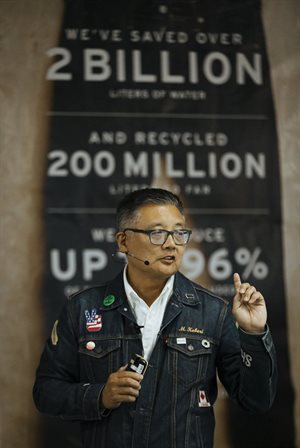Having never been inside an actual factory before, never mind a clothing factory, I had imagined mega-machines and giant conveyor belts - nothing but cold hard steel moving fabric about.
Upon a tour of the Levi's factory in Cape Town though, I was fondly surprised to find a seemingly endless sea of people - attaching zippers and buttons and studs and tags, churning out what you and I take for granted on the daily - denim wear.

Workers at the Levi's Epping factory with Michael Kobori and the local management team.
The manufacturing facility, together with its distribution operations, employs 480 people - something to cheer about in a country with a staggering rate of 29% unemployment. Apart from being short on jobs, however, we're also short on water resources and Cape Town, a year ago, could tell you all about what that's like - some of us are still carting buckets of shower water to the loo. While the Western Cape's dams are this winter season filling up faster than a Mi Casa concert, our changing climate means uncertainty in the long term.
And that's why we all have to embrace attitudinal and behavioural change - even big global brands like Levi Strauss & Co (LS&Co). Following my factory visit, I'm happy to report that they're on the right track.
501 life cycle assessment

Michael Kobori, Levi’s global vice president of sustainability
Levi’s global vice president of sustainability Michael Kobori joined us at the factory and shared some interesting statistics that the company's global team uncovered following a full life cycle assessment of their products. Shockingly, and you might want to put down your tea cup for this one, a single pair of 501's, they discovered, requires 3,781 litres of water from cradle to grave. Needless to say, there were a few horrified gasps around the room on hearing this.
Of the 3,781 litres, more than 66% is used to grow the cotton, roughly 20% is used by you and I as consumers, while manufacturing utilises only about 13%. With this knowledge, Levi's now knows where to concentrate its water-saving efforts.
Sharing the brand's global approach, Kobori highlighted Levi's work with the Better Cotton Initiative (BCI) which teaches farmers how to use both less water and chemicals while still producing greater yields. Last year, he noted, 68% of all Levi's products were made using various sustainable cotton initiatives, including BCI, and in 2020 its goal is 100%.
In the manufacturing process, Levi's has adopted its trademark WaterLess approach in its finishing process i.e. how they deliver you that been-working-the-mines-since-sunrise look. According to Kobori, this approach can use up to 96% less water in the manufacturing process and since its adoption, the brand has saved 3 billion litres of water, and that's just applying the WaterLess approach to 67% of all their products since last year. Its goal is 100%.
Local efforts
Unpacking what Levi's is doing on the local front, Gavin van der Horst, director of manufacturing, sourcing, planning and distribution, noted that various WaterLess techniques are used in over 80% of the product manufactured at the Epping facility, close to its goal of 100% by 2020. The results so far: it has reduced water usage in the production process by more than 30% over the last two years.

Local employees at the Levi's Epping factory.
To help the plant reach its 100% WaterLess production target by 2020, Levi's has signed on to an exciting partnership with the City of Cape Town. Set to come online later this year, it involves an extension of the Athlone Wastewater Treatment Works treated effluent network, taking the pipeline a further 2km to Epping and allowing the Levi’s manufacturing facility access to recycled water. With its own water treatment plant on site, the factory will send the used water back out to the Athlone plant.
The project is just getting under way and is due to be complete in October this year.

City of Cape Town's mayoral committee member for water and waste, Councilor Xanthea Limberg and Gavin van Der Horst, Levi’s director of manufacturing, sourcing, planning and distribution getting a briefing on the recycled water project.
Another local water-saving project it’s involved in is its partnership with The Nature Conservancy's Greater Cape Town Water Fund. Through its Levi’s Foundation, LS&Co has provided a three-year grant of $100,000 to support the initiative which enables downstream water users (cities, businesses, utilities) to invest in upstream conservation projects that protect nature’s ability to replenish watersheds more effectively. One such project involves the removal of invasive plants that prevent Cape Town’s reservoirs and aquifers from being replenished.
Future is green
It's clear from all of the above that Levi's is certainly striving to do its bit on the sustainability front, both globally and locally, and Kobori noted that millennials have had quite a bit to do with this. Call them lazy and entitled if you please, but they're also motivating brands like Levi's to do better for people and the planet, and with the incoming future-sustainability-conscious Gen Z putting further pressure on brands, they're going to have to authentically walk the green talk for a long, long time to come.





































